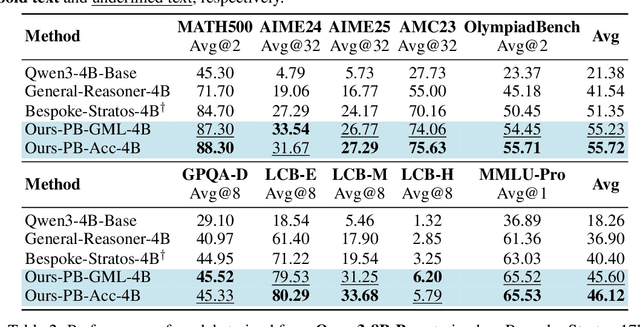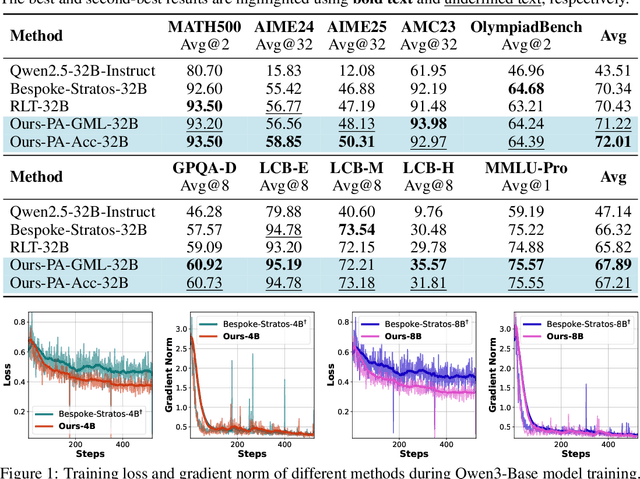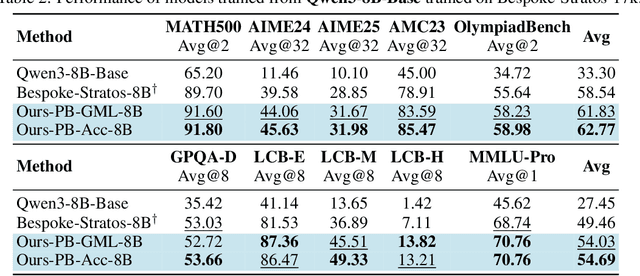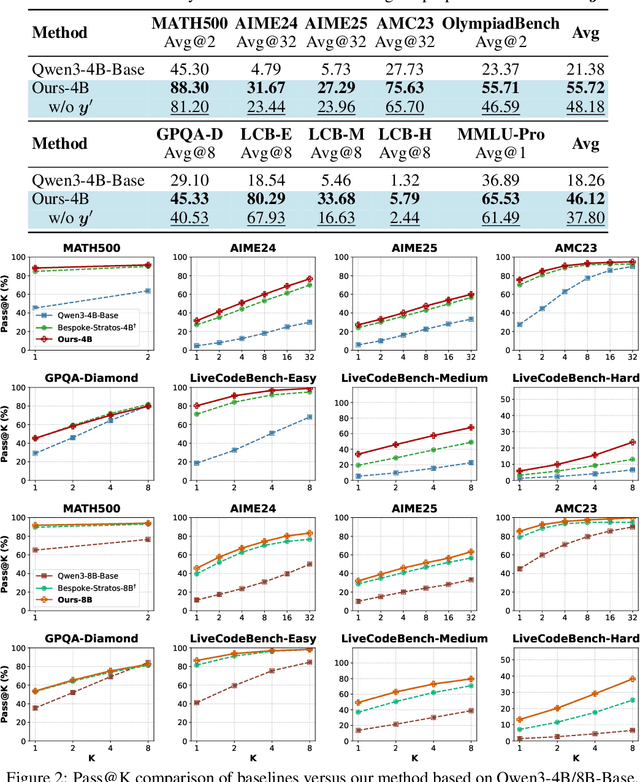Zichen Liu
Defeating the Training-Inference Mismatch via FP16
Oct 30, 2025Abstract:Reinforcement learning (RL) fine-tuning of large language models (LLMs) often suffers from instability due to the numerical mismatch between the training and inference policies. While prior work has attempted to mitigate this issue through algorithmic corrections or engineering alignments, we show that its root cause lies in the floating point precision itself. The widely adopted BF16, despite its large dynamic range, introduces large rounding errors that breaks the consistency between training and inference. In this work, we demonstrate that simply reverting to \textbf{FP16} effectively eliminates this mismatch. The change is simple, fully supported by modern frameworks with only a few lines of code change, and requires no modification to the model architecture or learning algorithm. Our results suggest that using FP16 uniformly yields more stable optimization, faster convergence, and stronger performance across diverse tasks, algorithms and frameworks. We hope these findings motivate a broader reconsideration of precision trade-offs in RL fine-tuning.
BinCtx: Multi-Modal Representation Learning for Robust Android App Behavior Detection
Oct 16, 2025Abstract:Mobile app markets host millions of apps, yet undesired behaviors (e.g., disruptive ads, illegal redirection, payment deception) remain hard to catch because they often do not rely on permission-protected APIs and can be easily camouflaged via UI or metadata edits. We present BINCTX, a learning approach that builds multi-modal representations of an app from (i) a global bytecode-as-image view that captures code-level semantics and family-style patterns, (ii) a contextual view (manifested actions, components, declared permissions, URL/IP constants) indicating how behaviors are triggered, and (iii) a third-party-library usage view summarizing invocation frequencies along inter-component call paths. The three views are embedded and fused to train a contextual-aware classifier. On real-world malware and benign apps, BINCTX attains a macro F1 of 94.73%, outperforming strong baselines by at least 14.92%. It remains robust under commercial obfuscation (F1 84% post-obfuscation) and is more resistant to adversarial samples than state-of-the-art bytecode-only systems.
Language Models Can Learn from Verbal Feedback Without Scalar Rewards
Sep 26, 2025Abstract:LLMs are often trained with RL from human or AI feedback, yet such methods typically compress nuanced feedback into scalar rewards, discarding much of their richness and inducing scale imbalance. We propose treating verbal feedback as a conditioning signal. Inspired by language priors in text-to-image generation, which enable novel outputs from unseen prompts, we introduce the feedback-conditional policy (FCP). FCP learns directly from response-feedback pairs, approximating the feedback-conditional posterior through maximum likelihood training on offline data. We further develop an online bootstrapping stage where the policy generates under positive conditions and receives fresh feedback to refine itself. This reframes feedback-driven learning as conditional generation rather than reward optimization, offering a more expressive way for LLMs to directly learn from verbal feedback. Our code is available at https://github.com/sail-sg/feedback-conditional-policy.
Variational Reasoning for Language Models
Sep 26, 2025



Abstract:We introduce a variational reasoning framework for language models that treats thinking traces as latent variables and optimizes them through variational inference. Starting from the evidence lower bound (ELBO), we extend it to a multi-trace objective for tighter bounds and propose a forward-KL formulation that stabilizes the training of the variational posterior. We further show that rejection sampling finetuning and binary-reward RL, including GRPO, can be interpreted as local forward-KL objectives, where an implicit weighting by model accuracy naturally arises from the derivation and reveals a previously unnoticed bias toward easier questions. We empirically validate our method on the Qwen 2.5 and Qwen 3 model families across a wide range of reasoning tasks. Overall, our work provides a principled probabilistic perspective that unifies variational inference with RL-style methods and yields stable objectives for improving the reasoning ability of language models. Our code is available at https://github.com/sail-sg/variational-reasoning.
Hallucination at a Glance: Controlled Visual Edits and Fine-Grained Multimodal Learning
Jun 08, 2025Abstract:Multimodal large language models (MLLMs) have achieved strong performance on vision-language tasks but still struggle with fine-grained visual differences, leading to hallucinations or missed semantic shifts. We attribute this to limitations in both training data and learning objectives. To address these issues, we propose a controlled data generation pipeline that produces minimally edited image pairs with semantically aligned captions. Using this pipeline, we construct the Micro Edit Dataset (MED), containing over 50K image-text pairs spanning 11 fine-grained edit categories, including attribute, count, position, and object presence changes. Building on MED, we introduce a supervised fine-tuning (SFT) framework with a feature-level consistency loss that promotes stable visual embeddings under small edits. We evaluate our approach on the Micro Edit Detection benchmark, which includes carefully balanced evaluation pairs designed to test sensitivity to subtle visual variations across the same edit categories. Our method improves difference detection accuracy and reduces hallucinations compared to strong baselines, including GPT-4o. Moreover, it yields consistent gains on standard vision-language tasks such as image captioning and visual question answering. These results demonstrate the effectiveness of combining targeted data and alignment objectives for enhancing fine-grained visual reasoning in MLLMs.
Reinforcement Learning Optimization for Large-Scale Learning: An Efficient and User-Friendly Scaling Library
Jun 06, 2025Abstract:We introduce ROLL, an efficient, scalable, and user-friendly library designed for Reinforcement Learning Optimization for Large-scale Learning. ROLL caters to three primary user groups: tech pioneers aiming for cost-effective, fault-tolerant large-scale training, developers requiring flexible control over training workflows, and researchers seeking agile experimentation. ROLL is built upon several key modules to serve these user groups effectively. First, a single-controller architecture combined with an abstraction of the parallel worker simplifies the development of the training pipeline. Second, the parallel strategy and data transfer modules enable efficient and scalable training. Third, the rollout scheduler offers fine-grained management of each sample's lifecycle during the rollout stage. Fourth, the environment worker and reward worker support rapid and flexible experimentation with agentic RL algorithms and reward designs. Finally, AutoDeviceMapping allows users to assign resources to different models flexibly across various stages.
Reinforcing General Reasoning without Verifiers
May 27, 2025Abstract:The recent paradigm shift towards training large language models (LLMs) using DeepSeek-R1-Zero-style reinforcement learning (RL) on verifiable rewards has led to impressive advancements in code and mathematical reasoning. However, this methodology is limited to tasks where rule-based answer verification is possible and does not naturally extend to real-world domains such as chemistry, healthcare, engineering, law, biology, business, and economics. Current practical workarounds use an additional LLM as a model-based verifier; however, this introduces issues such as reliance on a strong verifier LLM, susceptibility to reward hacking, and the practical burden of maintaining the verifier model in memory during training. To address this and extend DeepSeek-R1-Zero-style training to general reasoning domains, we propose a verifier-free method (VeriFree) that bypasses answer verification and instead uses RL to directly maximize the probability of generating the reference answer. We compare VeriFree with verifier-based methods and demonstrate that, in addition to its significant practical benefits and reduced compute requirements, VeriFree matches and even surpasses verifier-based methods on extensive evaluations across MMLU-Pro, GPQA, SuperGPQA, and math-related benchmarks. Moreover, we provide insights into this method from multiple perspectives: as an elegant integration of training both the policy and implicit verifier in a unified model, and as a variational optimization approach. Code is available at https://github.com/sail-sg/VeriFree.
Silent Leaks: Implicit Knowledge Extraction Attack on RAG Systems through Benign Queries
May 21, 2025Abstract:Retrieval-Augmented Generation (RAG) systems enhance large language models (LLMs) by incorporating external knowledge bases, but they are vulnerable to privacy risks from data extraction attacks. Existing extraction methods typically rely on malicious inputs such as prompt injection or jailbreaking, making them easily detectable via input- or output-level detection. In this paper, we introduce Implicit Knowledge Extraction Attack (IKEA), which conducts knowledge extraction on RAG systems through benign queries. IKEA first leverages anchor concepts to generate queries with the natural appearance, and then designs two mechanisms to lead to anchor concept thoroughly 'explore' the RAG's privacy knowledge: (1) Experience Reflection Sampling, which samples anchor concepts based on past query-response patterns to ensure the queries' relevance to RAG documents; (2) Trust Region Directed Mutation, which iteratively mutates anchor concepts under similarity constraints to further exploit the embedding space. Extensive experiments demonstrate IKEA's effectiveness under various defenses, surpassing baselines by over 80% in extraction efficiency and 90% in attack success rate. Moreover, the substitute RAG system built from IKEA's extractions consistently outperforms those based on baseline methods across multiple evaluation tasks, underscoring the significant privacy risk in RAG systems.
Optimizing Anytime Reasoning via Budget Relative Policy Optimization
May 19, 2025



Abstract:Scaling test-time compute is crucial for enhancing the reasoning capabilities of large language models (LLMs). Existing approaches typically employ reinforcement learning (RL) to maximize a verifiable reward obtained at the end of reasoning traces. However, such methods optimize only the final performance under a large and fixed token budget, which hinders efficiency in both training and deployment. In this work, we present a novel framework, AnytimeReasoner, to optimize anytime reasoning performance, which aims to improve token efficiency and the flexibility of reasoning under varying token budget constraints. To achieve this, we truncate the complete thinking process to fit within sampled token budgets from a prior distribution, compelling the model to summarize the optimal answer for each truncated thinking for verification. This introduces verifiable dense rewards into the reasoning process, facilitating more effective credit assignment in RL optimization. We then optimize the thinking and summary policies in a decoupled manner to maximize the cumulative reward. Additionally, we introduce a novel variance reduction technique, Budget Relative Policy Optimization (BRPO), to enhance the robustness and efficiency of the learning process when reinforcing the thinking policy. Empirical results in mathematical reasoning tasks demonstrate that our method consistently outperforms GRPO across all thinking budgets under various prior distributions, enhancing both training and token efficiency.
Improving the Euclidean Diffusion Generation of Manifold Data by Mitigating Score Function Singularity
May 15, 2025Abstract:Euclidean diffusion models have achieved remarkable success in generative modeling across diverse domains, and they have been extended to manifold case in recent advances. Instead of explicitly utilizing the structure of special manifolds as studied in previous works, we investigate direct sampling of the Euclidean diffusion models for general manifold-constrained data in this paper. We reveal the multiscale singularity of the score function in the embedded space of manifold, which hinders the accuracy of diffusion-generated samples. We then present an elaborate theoretical analysis of the singularity structure of the score function by separating it along the tangential and normal directions of the manifold. To mitigate the singularity and improve the sampling accuracy, we propose two novel methods: (1) Niso-DM, which introduces non-isotropic noise along the normal direction to reduce scale discrepancies, and (2) Tango-DM, which trains only the tangential component of the score function using a tangential-only loss function. Numerical experiments demonstrate that our methods achieve superior performance on distributions over various manifolds with complex geometries.
 Add to Chrome
Add to Chrome Add to Firefox
Add to Firefox Add to Edge
Add to Edge